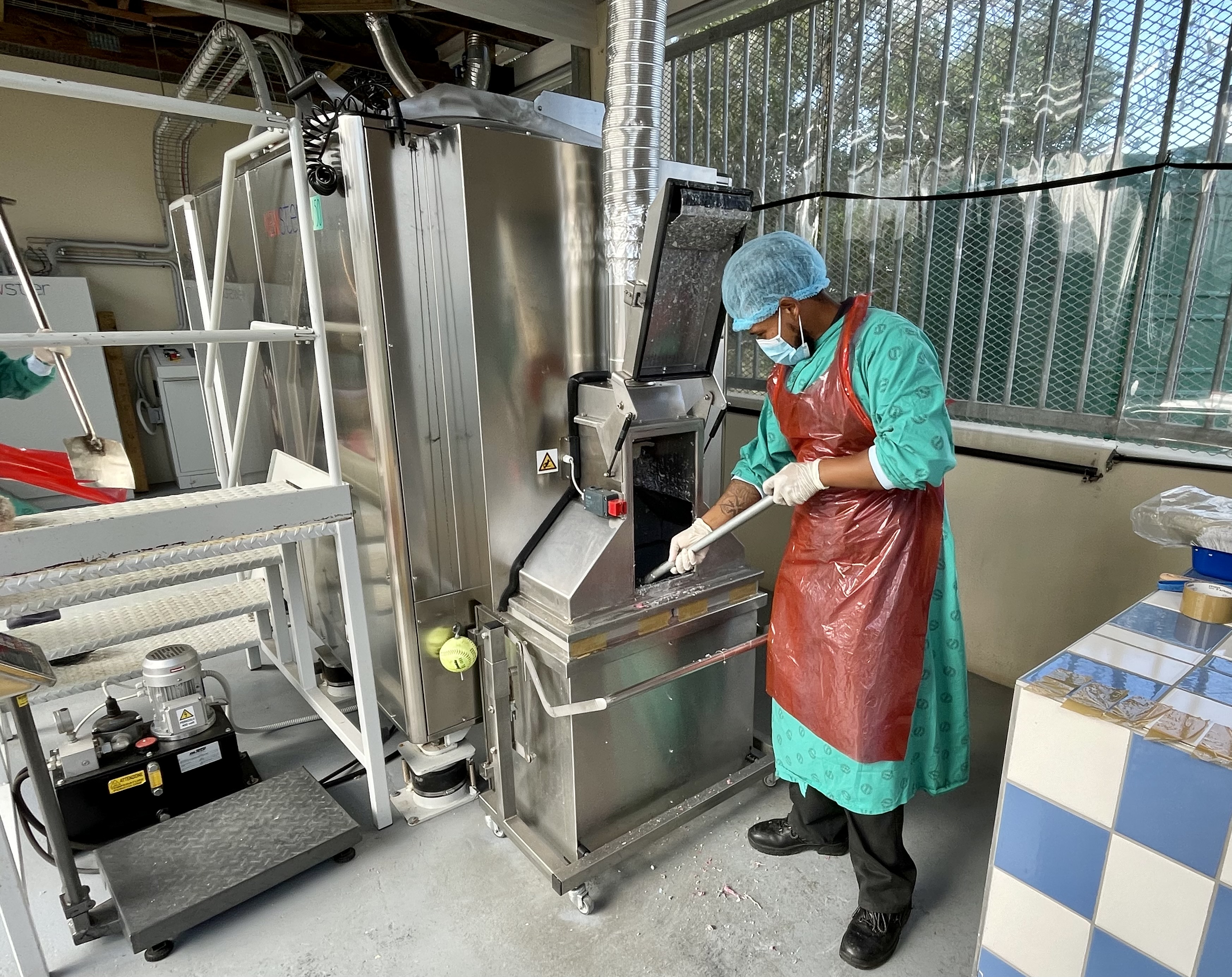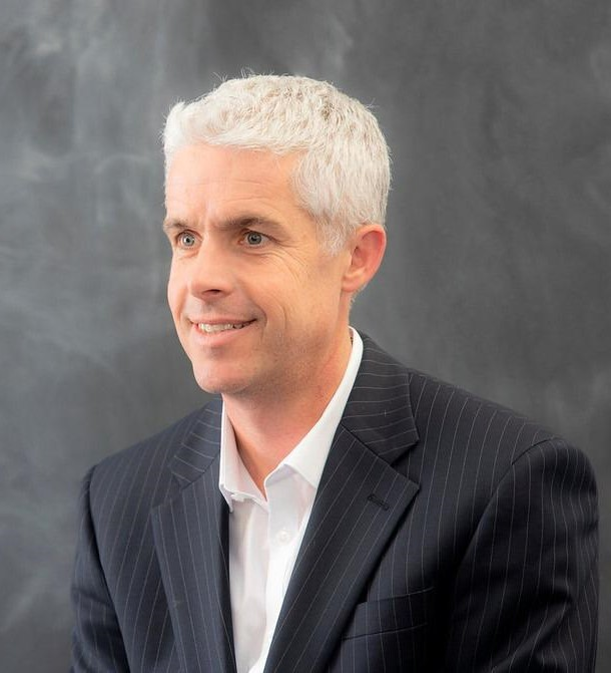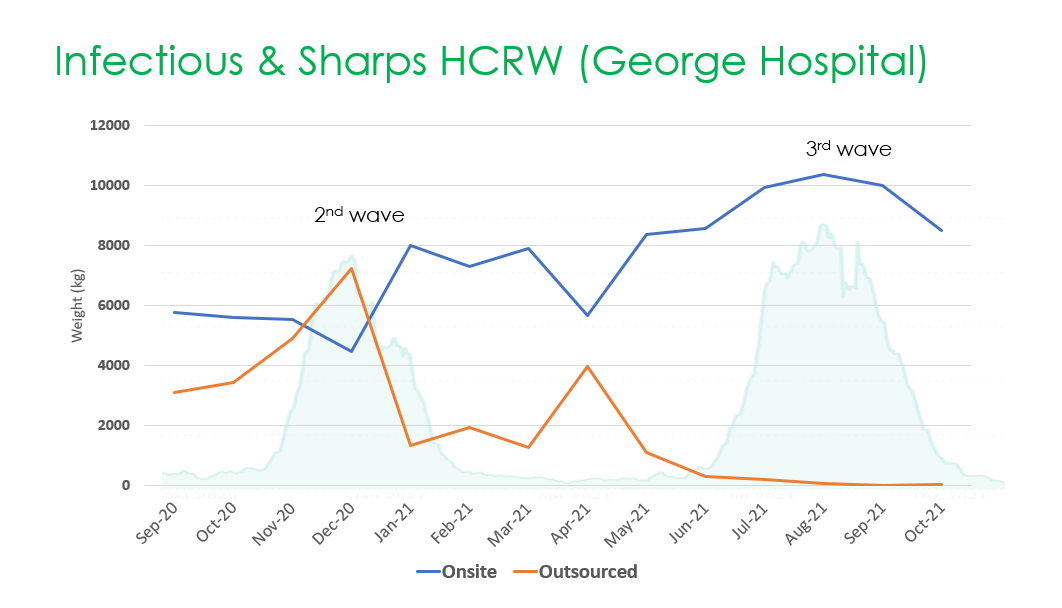Onsite treatment of hazardous waste reduces GHG and expenses for a rural South African hospital
George Regional Hospital, Department of Health, Western Cape, South Africa.
Case study summary
The transition from offsite and outsourced to onsite treatment of infectious waste has significantly reduced George Hospital’s carbon footprint. The installation of equipment that treats health care risk waste (hazardous waste) through mechanical – and microwave technology that allows for its safe disposal in a local landfill reduces emissions from incineration, which is the main form of treating health care risk waste in South Africa.
Demographic information
- City: George
- State/province/region: Western Cape
- Country: South Africa
- Type of institution: Rural Regional Hospital
- Number of full-time staff: 780
- Number of part-time staff: 22
- Number of beds: 285
- 713, 225 patients served annually
- Geographic area served: 62,185 square kilometers
- Health equity concerns experienced by your population:
- Rural Area - Access to health care services due to distance to travel to health care facility.
- Poverty – high unemployment rate
- High burden of disease
- Infectious Diseases (HIV/TB)
- Violence / Trauma
- Non-communicable disease (e.g. diabetes, mental health)
- Maternal and Child Health
The issue
South Africa is ranked as the most unequal country in the world, where the local population is confronted daily with poverty and massive health inequalities. The direct and indirect effects of climate change have the potential to amplify existing the health challenges; adversely affecting the most vulnerable and marginalized populations.
Located in the rural Garden Route District, the hospital faced the challenge of transporting health care risk waste five times per week to a waste treatment plant nearly 450 kilometres away in Cape Town. The hospital was dependent on an outside contractor to comply with regulations pertaining to transport and disposal, at a significant financial cost. The carbon footprint generated during transportation, treatment, and disposal was significant. The sharps waste was incinerated, contributing further to the negative environmental impact.

Hospital goals
By applying the “Proximity Principle of Waste Management,” the hospital aimed to:
- Significantly reduce the carbon footprint associated with the transportation of waste to a treatment facility.
- Stop the incineration of sharps.
- Reduce the cost of disposal and treatment of health care risk waste.
- Eliminate the risk of contamination during transportation of health care risk waste.
Sustainability strategy implemented
The hospital implemented a Newster NW50 sterilizer, which mechanically demolishes and sterilizes infectious and sharps waste under high temperatures in a closed pressure vessel. A commissioned independent chemical and microbiological analysis showed that the treated waste was sterile and appropriate for landfill. This assisted with obtaining approval from the relevant authorities. The equipment does not require highly skilled operators. Once the waste is loaded into the machine, the process is fully automated. Printouts after each cycle confirm that sterilization has been achieved. Periodical sterilization efficiency is confirmed weekly using biological indicators. The sterilized waste is safely disposed of in a local landfill, reducing the carbon footprint and risk of contamination.

This model has shown great interest from other public and private hospitals, which are considering this technology. There is an urgent call to action for hospitals to move away from medical waste incinerators and engage in sustainable models of waste disposal by procuring onsite treatment methods like this that will save them cost, and are more environmentally friendly.
Implementation process
The decision to proceed with the project followed a small-scale pilot of Newster technology at a hospital in Cape Town. From the pilot, it was clear that if the Newster sterilizer was implemented at a larger scale (i.e. the scale as needed at George Hospital), the carbon footprint savings due to reduced transportation distances would be significant; alongside the anticipated financial benefits. The project required establishing a physical space for the plant. This resulted in the hospital funding the renovation work of an existing building, including the provision of necessary services (water and electricity). Capital funding for the equipment was provided by the Western Cape Government Health Department which committed to Race to Zero.
Installation was due to commence in March 2020 but was delayed by the COVID-19 pandemic regulations which prevented the Newster technicians from flying from Italy to South Africa to install the sterilizer, as well as the independent microbiological and chemical analysis. Despite these challenges, the unit was fully commissioned in August 2020, enabled by excellent support from the equipment supplier and hospital staff. During the early stages of use, there were some challenges due to the incorrect segregation of health care risk waste that could have potentially damaged the equipment, for example, linen disposed of in infectious waste. However, this was resolved by delivering training to the ward staff. The equipment supplier signed a contract with the hospital agreeing to provide maintenance of the machine, mitigating any risk due to equipment failure.
Tracking progress
The hospital completed a phased commissioning of the unit; initially treating infectious waste only, then adding sharps, and finally hazardous COVID-19 waste. The hospital tracks the volume and weight of waste treated daily using an Excel spreadsheet, ensuring it remains below the 500-kilogram limit as per regulations. The electricity consumption is also monitored periodically using a dedicated meter, as part of the hospital’s plan to reduce energy consumption and manage peak load. Currently, the average cycle takes 25 minutes with 30 kilowatt-hours of energy being used per cycle.
Figure 1: The onsite treatment of health care risk waste was critical to the hospital’s COVID-19 response. Twelve months after commissioning, all infectious and sharps waste was treated onsite. This coincided with the third and largest wave of the COVID-19 pandemic when daily infectious waste generated by hospitals was also at its highest.


Progress achieved
The transition from an outsourced offsite service to an onsite treatment of infectious waste has resulted in a 99% reduction in transport emissions from previous practice, equivalent to 218,000 kilometers pa or 254,000 kilograms CO2 per year. During processing, the volume of waste is reduced by approximately 75%, with the benefit of a significant reduction in volume disposed in landfills. Infectious and sharps waste, which was previously incinerated, is also safely treated on-site. There has been a substantial saving operational cost of 45% (US 70,000 pa). The project has supported local economic development, employing two waste operators, and a local supplier subcontracted to manage routine maintenance.
From a safety perspective, waste is turned into a non-recognizable and harmless material, with no visible sharps, reducing the chance of injury to almost negligible and eliminating the risk of contamination to the environment during transportation or disposal.
Challenges and lessons learned
The procurement and commissioning of an onsite waste treatment unit involves multiple stakeholders and contractors and thus has the potential for lengthy delays. Leadership is critical to ensure the buy-in of all parties and rigorous project management is needed to anticipate and address obstacles. The management and disposal of health care risk waste is a highly regulated environment. Knowledge of the necessary legislation and regulations, as well as proactive engagement with authorities responsible for waste management is critical to get approval and support for such initiatives.
Next steps
As part of the hospital’s commitment to achieve net zero, there are ongoing projects to improve the efficiency of the waste management processes, including:
- Reviewing the timings of the onsite waste treatment operations to reduce average peak power demand, resulting in a lower energy tariff.
- Reducing the volume of infectious waste generated and treated onsite, through improved waste segregation by continuous staff training.
- Installation of a 638.20 kilowatts peak (kWp) solar plant in 2023 to supplement the hospital’s energy usage.
Newster technology has been implemented at a further six hospitals in the Western Cape and the provincial health department is considering further expansion.